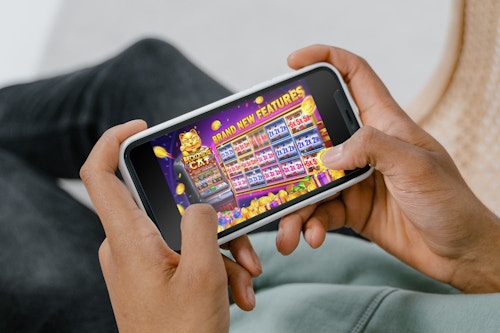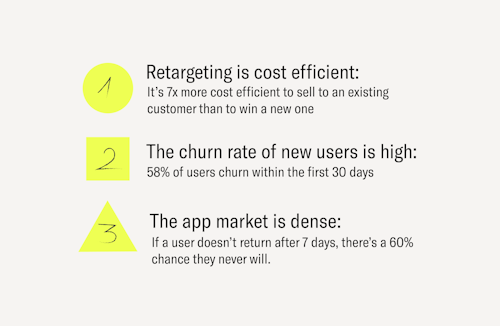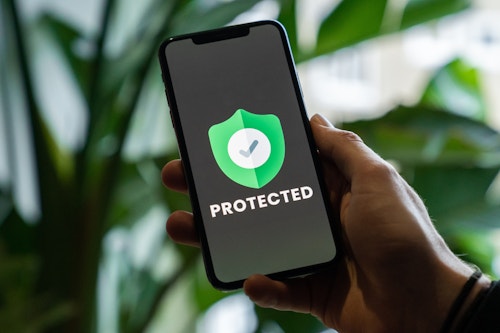The most common dos and don’ts of app retargeting
August 15, 2022

You’ve reviewed your retention strategy and want to try retargeting. But what next? How do you get started? And what’s the best way to achieve your goals?
Here is some of the most common advice we give app marketers who are getting started with in-app retargeting.
Do determine your primary retargeting goals
Running app retargeting campaigns can be daunting at first, but the initial steps are simple. First, you need to define your goals.
What are your KPIs? How can retargeting help improve them?
User funnel
This starts with a conversation about the user funnel. Where do you need to move users? For some apps, such as subscription services, you may need to get them through that first sign-up stage. For others, it’s about pushing users further down the funnel until they finally convert (e.g. by making a purchase). In some cases, the goal will be to ensure that users in the lower part of the funnel - who tend to be extremely valuable frequent-purchasers - don’t drop off or churn.
Once you’ve analyzed this, you can start segmenting your app audience based on how you want to target them. In our experience, it’s best to start with the basics - this provides a benchmark for performance before moving into a more intricate and granular set up.
The initial set up
Start by identifying the point of churn. For instance, where do you see in-app activity decrease?
Next, look at your attribution windows. It is essential to determine how to unify your metrics, so you don’t attribute the in-app activity from your retargeting campaigns with other campaigns you’re running.
Analyze the user flow from ad to app. It’s important to minimize any friction that could prevent your targeted user from opening the app and completing the desired action(s). Deep links are a powerful tool here - they remove any obstacles from the user pathway.
Also, make room to look beyond the primary KPI to focus on other re-engagement metrics. This lets you see and analyze what other in-app activity is happening as a result of your retargeting campaigns.
« App retargeting and user acquisition are separate concepts, so it’s unwise to rely on insights from the latter to inform the former. »
Do outline the value proposition for your user
You’ve established how your retargeting campaigns will benefit your business - now it’s time to consider how they will benefit your users.
Creatives
Great creatives are a key part of retargeting. We’ve observed a notable difference in performance when clients are serious about strategic creatives. Our in-house design team has consulted with thousands of apps over the years, so we’ve learned a lot about what works and what doesn’t. In a nutshell: creatives must be compelling.
The goal of user acquisition creatives is typically to encourage download. But for retargeting, you’re asking users to engage on a much deeper level - most likely with their time or money. This means each user group will require different creatives, as a call-to-action might read very differently for a lapsed payer compared to an active non-payer.
Remember, sales and promotions might not be compelling for every app. In these cases, find specific content pieces, interesting features, or new releases that can bring creatives to life, get a user’s attention and encourage them to revisit your app.

Read to learn how we designed retargeting creatives for Triwin Games
Do give your campaign some time
Once everything is up and running, give the campaign some time.
People new to app retargeting sometimes fall into the habit of attempting to draw conclusions from data after 48 hours. While you will see a trend line within this timeframe, the true and full impact of your retargeting campaigns will not become apparent until after a longer period of time.
This is best illustrated with an example from one of our e-commerce clients. The client wanted to retarget previous purchasers and assumed they would capture all revenue from the retargeting campaign within the first 24 hours of its launch. They felt users would cease to show any significant in-app activity after day 1, much less a purchase.
After testing this hypothesis with our cohort analysis tool, we found that users actually continued to purchase 30 days after the point of being re-engaged. This insight was particularly useful and only attainable by analyzing larger activity windows.
Don't rely solely on user acquisition insights
App retargeting and user acquisition are separate concepts, so it’s unwise to rely on insights from the latter to inform the former. Those new to retargeting often assume the goal is to capture a user’s attention, when in reality, it’s about inviting intention.
A strategy that has worked to get a user’s attention and prompt them to download an app won’t necessarily work to re-engage that same user once they have lapsed, so it’s key to compartmentalize those insights into separate buckets.
Customized Creatives
Your creative strategy for retargeting shouldn’t be a replica of your approach for user acquisition campaigns. We advise our clients to avoid recycling user acquisition creative assets, as install-focused ads serve a different purpose. For retargeting, revert back to your primary goal and adapt messaging and visuals to that goal for better performance.
Matching the creative to the action you’d like users to take is key. For Triwin Games, we designed specific retargeting ads to encourage users to return to Tycoon Casino and make a repeat purchase. The ads reflected the same look and feel of the app and the next steps they could take in the game. We promoted time-limited game promotions to entice users to return to the game and the smooth transition from the ad to app attracted gamers to convert.
Don't wait to get started with retargeting
One of the most common questions we hear from app marketers is when should I start retargeting?
We suggest considering these three points:

Attribution providers have done excellent work in analyzing the impact of how reengaged or reattributed users out-perform new installs on a 12 week time horizon. We also see that these users continue to be more active and more prevalent in the app, enticing app marketers to think “it shouldn’t be all about new users, but about maximizing the users we already have.”
Join our newsletter





